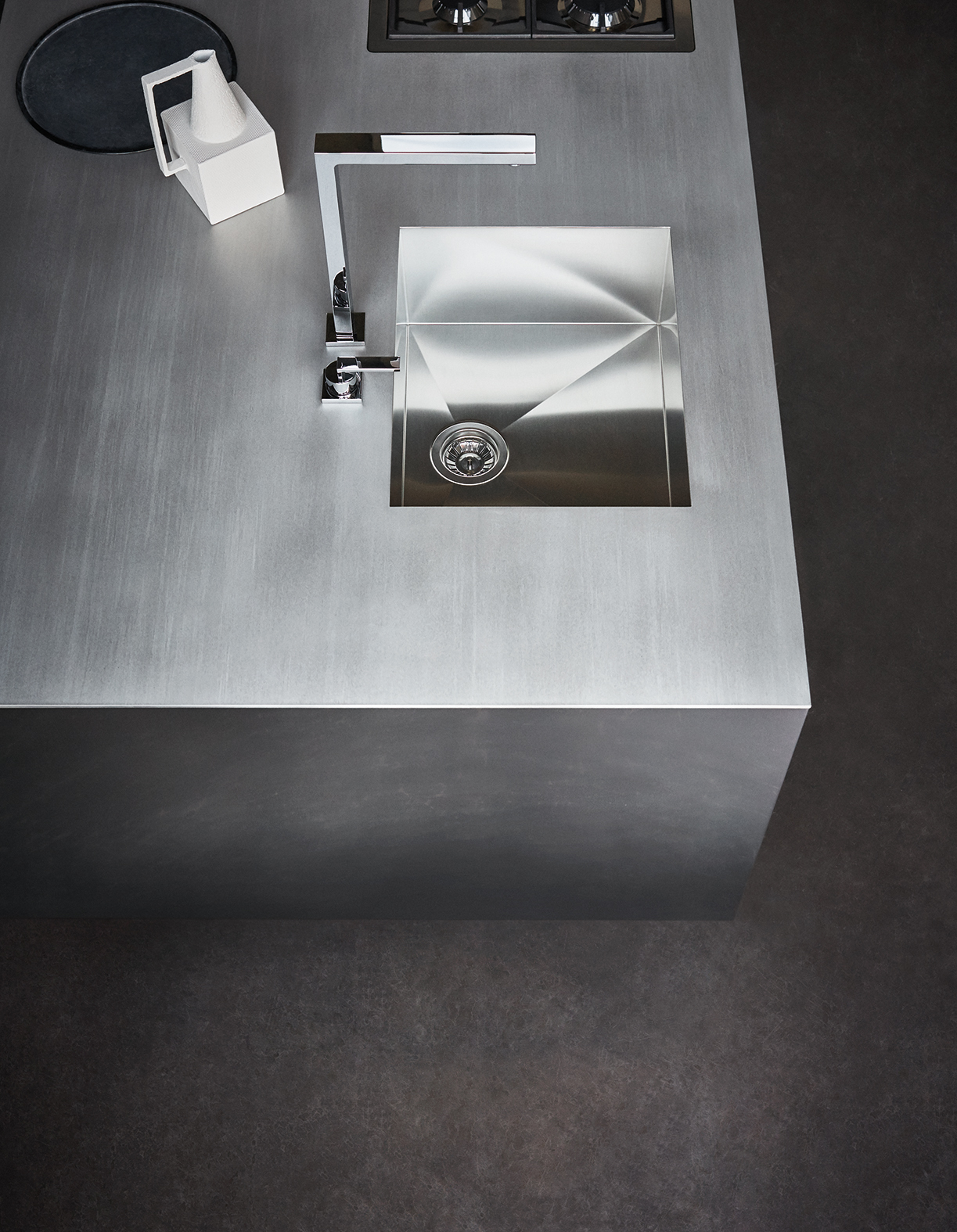Kitchens
Stainless steel

THE CLEANING AND MAINTENANCE OF A STAINLESS STEEL KITCHEN
For the daily maintenance and cleaning of a stainless steel surface, we suggest that you use a cloth with lukewarm water and some soap. You can also choose products specifically designed to treat stainless steel. The technique is simple, during cleaning, make the movements in the direction of the satin finish of the plate and rinse generously then dry with a dry cloth.
In the case of heavy stains, we suggest that you clean everything with:
- A mixture of water (80%) and vinegar (20%)
- Lemon juice, previously diluted in water
- Mild and non-abrasive cleaning products.
For the maintenance and durability of stainless steel, we also suggest that you:
- Avoid cutting food directly on the counter
- Quickly mop up water on the surface to prevent corrosion
- Avoid manipulating objects such as utensils on the work surface in order to prevent scratches
- Do not clean with abrasive or corrosive detergents
- Remove from the surface, within a reasonable time, all objects containing iron in order to avoid marks and stains
For the maintenance and durability of stainless steel, we also suggest:
- Not using scouring sponges
- Not using abrasive creams
- To avoid powdered products or detergents
- To avoid acetone and other solvents and thinners
- Not to put hot objects on the surface so that the surface retains its integrity
Kitchens that incorporate stainless steel are very practical, resistant, extremely trendy and give a touch of modernism to the room.
Stainless steel is non-porous and pairs beautifully with wood, stone, and textiles. It is a material as practical as it is aesthetic. Timeless, it integrates with all styles in addition to being extremely durable and adds clarity and brightness to the room.
Stainless steel is a term used to designate steel with a high chromium and nickel content. It is by these characteristics that stainless steel resists corrosion and demonstrates unparalleled resistance. Resistant to heat, cold and stains, stainless steel is a wise choice if you want your countertop to remain in good condition, even for 30 years.
Durable, fully recyclable (it is one of the rare materials that can be recycled over and over again without losing its properties) and without toxic emissions, stainless steel perfectly the concept of sustainable development.
Stainless steel is often used in professional-style kitchens as well as in the hospital environment and it is not a coincidence. Since it is non-porous, it is a very hygienic and easy-care material.
AVAILABLE FINISHES
Steel can withstand a multitude of treatments that transform its smooth, reflective surface into a soft, silky surface. Recent years have seen a variety of finishes appear in stainless steel surfaces. Here are, for example, the available finishes:
- Satin stainless steel
- Trama stainless steel
- Vintage stainless steel
- Ice stainless steel
In addition to being available in several thicknesses and in a variety of finishes, stainless steel can be worked in many ways to create interesting details. For example, a full sheet of 4mm will give an effect of ultra modern lightness. One of the main advantages of stainless steel is that you can also create molded sinks as well as fused cooking units, not to mention the fact that you can make very large surfaces, counters or backsplashes without apparent joints.
WHAT IS STAINLESS STEEL?
Stainless steel is an alloy made from iron and carbon that contains less than 1.2% carbon and more than 10.5% chromium. This allows it to be extremely resistant to corrosion. Other elements can be added to it, such as nickel, which improves the performance of the steel.
PARTICULARITIES AND ADVANTAGES OF STAINLESS STEEL
Stainless steel is usually offered in satin and vintage finishes. The satin finish undergoes a treatment of mechanical scratches and is always uniform while the vintage finish receives the same treatment but by hand in an artisanal way.
Regardless of the choice of finish, stainless steel has several particularities and qualities including:
- Exceptional resistance to stains
- Resistance to heat and corrosion
- An easy-to-clean and hygienic surface
- Durability
STAINLESS STEEL AN EXCELLENT CHOICE FOR THE PLANET
Stainless steel is an ecological and eco-responsible choice because it is 100% and above all infinitely recyclable. Its complete and autonomous recycling reduces CO2 emissions because no other material is added or integrated.
STAINLESS STEEL KITCHEN FRONTS
The process of making a stainless steel front is quite simple. A welded steel plate with angles is often attached to a polymer foam board containing an anodized aluminum plate on top. In order to prevent stains from oil, grease or any other product and to facilitate maintenance and cleaning, a treatment with products derived from nanotechnology is then applied.
STAINLESS STEEL KITCHEN COUNTERTOPS
Countertops, regardless of finish, are made of stainless steel sheets of varying thicknesses that are fixed, bent and welded to a water-repellent particle board. It is also possible to add a stainless steel backsplash or credenza to the worktops. In addition, the hob or the sink can be welded directly to the stainless steel worktop without visible joints for a refined and minimalist effect.

















your inner
world






















